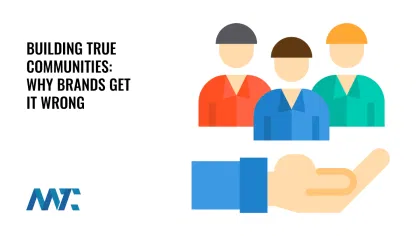
The idea of community has become a buzzword among marketers and businesses. Brands, eager to harness the power of collective engagement, often rush to create communities around their products. However, many make a critical mistake: they attempt to center their communities around the brand itself rather than the shared problems, beliefs, hobbies, or skills that genuinely bring people together.
This fundamentally flawed approach leads to communities that feel forced, transactional, and ultimately ineffective.
Table of Contents
What Makes a Community?
Real communities form organically around shared experiences and common interests. People gather in communities to connect with others who understand their challenges, passions, and values. Thriving communities emerge in response to:
- Problems that need solving: People seek solutions and support from others with similar experiences. From DIY home improvement forums to health support groups, communities thrive when members can exchange advice, troubleshoot issues, and share their journeys.
- Shared beliefs and values: Political movements, social justice initiatives, and religious groups rally around core ideologies. These communities persist because members are emotionally and intellectually invested in their shared cause.
- Hobbies and talents: Creative and recreational communities—from musicians to gamers, from photography enthusiasts to writers—flourish when members can showcase their work, improve their craft, and inspire one another.
- Aspirations and lifestyle choices: Fitness communities, personal finance groups, and professional networks thrive because people bond over shared ambitions and milestones.
These foundational elements of community building are not about products or brands. They are about the people within the community and what drives them.
The Fatal Mistake: Making It About the Brand
Too often, brands create communities centered around themselves rather than the needs of the people they are trying to engage. They launch branded forums, social media groups, or exclusive memberships that revolve around the company’s offerings, expecting customers to rally around their marketing goals. The result? A community that lacks authenticity, feels like an extended sales pitch, and fails to foster genuine engagement.
Why This Doesn’t Work
- People don’t care about brands—they care about their own needs. A customer who buys running shoes doesn’t want to join a Nike Enthusiasts group. They want a space to discuss training routines, injury prevention, and marathon strategies.
- Forced brand loyalty feels inauthentic. Communities thrive on trust, not manipulation. People disengage when a brand tries to control the conversation, pushing its products rather than fostering genuine discussion.
- Value comes from people helping people, not from brand messaging. The strength of a community is in peer-to-peer (P2P) interactions, not top-down communication from a company. Members gain value from shared experiences and user-generated solutions (UGC), not from a company rep promoting new features.
- The brand loses credibility. A community that exists primarily to increase sales is transparent in its intent. Customers recognize this and will likely see it as another marketing channel rather than a space for meaningful engagement.
The Right Approach: Building Communities That Thrive
Align With an Existing Passion, Problem, or Purpose
Instead of making the brand the focal point, brands should identify the larger conversation they can support. If a company sells photography gear, it should build a community around photography itself, not just its products. If a brand offers financial software, its community should focus on financial literacy, investment strategies, or small business growth.
Enable Customer-to-Customer Interaction
The real power of community lies in peer-to-peer conversations. A strong community allows members to exchange ideas, share best practices, and help each other succeed. This builds trust, loyalty, and long-term engagement without constant brand intervention.
Facilitate, Don’t Dominate
Brands should act as facilitators rather than dictators. They can provide platforms, tools, and occasional insights but should not control the dialogue. A great example is Reddit’s r/personalfinance, where people discuss financial strategies without constant input from banks or financial institutions.
Encourage Organic Advocacy, Not Forced Loyalty
If a community delivers real value, brand advocacy will happen naturally. People will share their success stories, discuss their favorite products, and recommend solutions without being prompted. Authentic word-of-mouth marketing (WOMM) is far more powerful than branded content.
Measure Success Differently
Instead of focusing on direct sales impact, brands should measure community success by engagement levels, problem-solving efficiency, and the strength of member interactions. A well-run community increases customer retention, reduces support costs, and builds long-term brand affinity—not through aggressive marketing but by providing genuine value.
The Real Value of Community
A great community is not a marketing gimmick—it’s a dynamic ecosystem where members support and empower each other. When brands shift their mindset from leveraging communities for sales to nurturing them for shared value, they create something far more powerful: a loyal, engaged group of people who feel genuinely connected to one another. That, in turn, builds lasting goodwill and trust toward the brand without the need for overt selling.
The lesson for businesses that foster authentic engagement is clear: Build communities around people, not products. Focus on conversations, not conversions. Above all, prioritize relationships over revenue. The returns—customer loyalty, trust, and long-term success—will follow naturally.